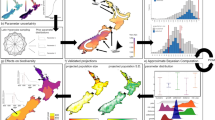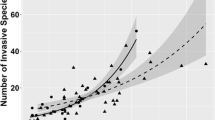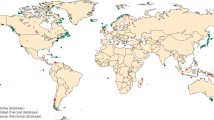Abstract
Island biogeographic theory offers a powerful conceptual framework for understanding and managing insular diversity. The human impact on insular environments is constantly growing, especially because of tourism. We performed a simulation study aimed at improving the understanding of the role of disturbance in islands. We also built an individual-oriented computer model of an archipelago subjected to chronic disturbance of varying degree. Results are discussed in the light of island biogeographic theory. Relevant results show the importance of autoecological characteristics of the species considered, regarding the attainment of equilibrium and the species-area relationship in both disturbed and undisturbed cases. The possibility of bias in the predictions of the equilibrium model is pointed out. Fundamental criticisms concerning the ecological relevance of the equilibrium theory are discussed.
Similar content being viewed by others
Literature Cited
Abbott, I. 1983. The meaning ofz in species/area regresions and the study of species turnover in island biogeography.Oikos 41:385–390.
Aizen, M. A. 1989. Fit of logspecies-logarea regression lines to nonequilibrium archipelagos: A simulation approach.Ecological Modelling 47:265–273.
Begon, M., J. L. Harper, and C. R. Townsend. 1990. Ecology. Blackwell, London, 945 pp.
Beller, W., P. d'Ayala, and P. Hein (eds.). 1990. Sustainable development and environmental management of small islands. Parthenon Press, Park Ridge, New Jersey, 419 pp.
Boecklen, W. J., and N. J. Gotelli. 1984. Island biogeographic theory and conservation practice: Species-area or specious-area relationship?Biological Conservation 29:63–80.
Brown, J. H., and A. Kodric-Brown. 1977. Turnover rates in island biogeography: Effect of immigration on extinction.Ecology 58:445–449.
Connor, E. F., and E. D. McCoy. 1979. The statistics and biology of the species-area relationship.American Naturalist 113:791–833.
Darwin, C. 1859. On the origin of species. Murray, London.
Diamond, J. M.. 1976. Island biogeography and conservation: Strategy and limitations.Science 193:1027–1029.
Diamond, J. M., and R. M. May. 1981. Island Biogeography and the design of natural reserves. Pages 228–252in R. M. May (ed.) Theoretical ecology: Principles and application. Blackwell, Oxford, UK.
Fenchel, T. 1974. Intrinsic rate of natural increase: The relationship with body size.Oecologia 14:317–326.
Gore, J. A., and A. M. Milner. 1990. Island bioeographic theory: Can it be used to predict lotic recovery rates?Journal of Environmental Management 14:737–753.
Gould, S. J. 1979. An allometric interpretation of species-area curves: The meaning of the coefficient.American Naturalist 114:335–343.
Have, A. 1987. Experimental island biogeography: Immigration and extinction of ciliates in microcosms.Oikos 50:218–224.
Hogeweg, P., and B. Hesper. 1990. Individual-oriented modelling in ecology.Mathematical and Computer Modeling 13:83–90.
Huston, M., D. DeAngelis, and W. Post. 1988. New computer models unify ecological theory.BioScience 38:682–690.
Kempton, R. A., and L. R. Taylor. 1974. Log-series and log-normal parameters as diversity discriminants for the Lepidoptera.Journal of Animal Ecology 43:381–399.
Loehle, C. 1990. Proper statistical treatment of species-area data.Oikos 57:143–145.
Lomolino, M. V.. 1984. Mammalian island biogeography: Effects of area, isolation and vagility.Oecologia 61:376–382.
Lomolino, M. V.. 1990. The target area hypothesis: The influence of island area on immigration rates of non-volant mammals.Oikos 57:297–300.
MacArthur, R. H., and E. O. Wilson. 1963. An equilibrium theory of insular zoogeography.Evolution 17:373–387.
MacArthur, R. H., and E. O. Wilson. 1967. The theory of island biogeography. Princeton University Press, Princeton, New Jersey, 203 pp.
May, R. M.. 1975. Patterns of species abundance and diversity. Pages 81–120in M. L. Cody, and J. M. Diamond (eds.), Ecology and evolution of communities. Harvard University Press, Cambridge, Massachusetts.
McCoy, E. D. 1982. The application of island-biogeographic theory to forest traits: Problems in the determination of turnover rates.Biological Conservation 22:217–227.
Osman, R. W. 1977. The establishment and development of a marine epifaunal community.Ecological Monographs 47:37–63.
Pianka, E. R.. 1970. Onr-andK-selection.American Naturalist 104:592–597.
Pimm, S. L., H. L. Jones, and J. Diamond. 1988. On the risk of extinction.American Naturalist 132:757–785.
Preston, F. W.. 1962. The canonical distribution of commonness and rarity.Ecology 43:182–215; 410–432.
Reed, T. M. 1983. The role of species-area relationships in reserve choice: A British example.Biological Conservation 25:263–271.
Schoener, T. W. 1983. Rate of species turnover decreases from lower to higher organisms: A review of the data.Oikos 41:372–377.
Schoener, T. W. 1988. On testing the MacArthur-Wilson model with data on rates.American Naturalist 131:847–864.
Seagle, S. W., and H. H. Shugart. 1985. Faunal richness and turnover on dynamic landscapes: A simulation study.Journal of Biogeography 12:499–508.
Simberloff, D. S., and L. G. Abele. 1976. Island biogeographic theory and conservation practice.Science 191:285–286.
Stenseth, N. C. 1981. How to control pest species: Application of models from the theory of island biogeography in formulating pest control strategies.Journal of Applied Ecology 18:773–794.
Sugihara, G. 1981.S=CZ z,z=1.4: A reply to Connor and McCoy.American Naturalist 117:790–793.
Taylor, R. A. 1978. The relation between density and distance of dispersing insects.Ecology and Entomology 3:63–70.
Terborgh, J. W. 1974. Faunal equilibria and the design of wildlife preserves.In F. Golley, and E. Medina (eds.), Tropical ecological systems: Trends in terrestrial and aquatic research. Springer-Verlag, New York.
Toft, C. A., and T. W. Schoener. 1983. Abundance and diversity of orb spiders on 106 Bahamian islands: Biogeography at an intermediate trophic level.Oikos 41:411–426.
Villa, F., F. Sartore, and O. Rossi. 1990. Ecological factors and the shape of the species-area relationship: A computer simulation study. Proceedings of the Italian Society of Ecology (SITE) 12:891–896.
Villa, F., F. Sartore, and O. Rossi. 1991. Ecological factors and the shape of the species-area relationship: A computer simulation study.
Williamson, M. 1981. Island populations. Oxford University Press, Oxford, UK. 286 pp.
Williamson, M. 1989a. The MacArthur and Wilson theory today: True but trivial.Journal of Biogeography 16:3–4.
Williamson, M. 1989b. Natural extinction on islands.Philosophical Transactions of the Royal Society of London 325:457–468.
Wilson, E. O., and E. O. Willis. 1975. Applied biogeography. Pages 522–534in M. L. Cody, and J. M. Diamond (eds.), Ecology and evolution of communities. Harvard University Press, Cambridge, Massachusetts.
World Resources Institute. 1986. World Resources 1986. Basic Books, New York.
Wright, S. J., and S. P. Hubbell. 1983. Stochastic extinction and reserve size: A focal species approach.Oikos 41:466–476.
Zimmerman, B. L., and R. G. Bierregaard. 1986. Relevance of the equilibrium theory of island biogeography and species-area relations to conservation with a case from Amazonia.Journal of Biogeography 13:133–143.
Author information
Authors and Affiliations
Rights and permissions
About this article
Cite this article
Villa, F., Rossi, O. & Sartore, F. Understanding the role of chronic environmental disturbance in the context of island biogeographic theory. Environmental Management 16, 653–666 (1992). https://doi.org/10.1007/BF02589019
Issue Date:
DOI: https://doi.org/10.1007/BF02589019




